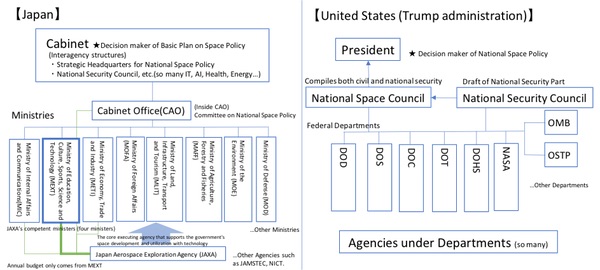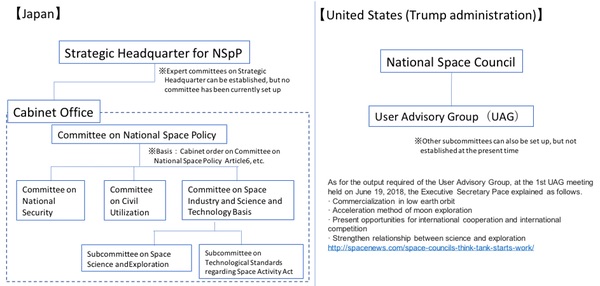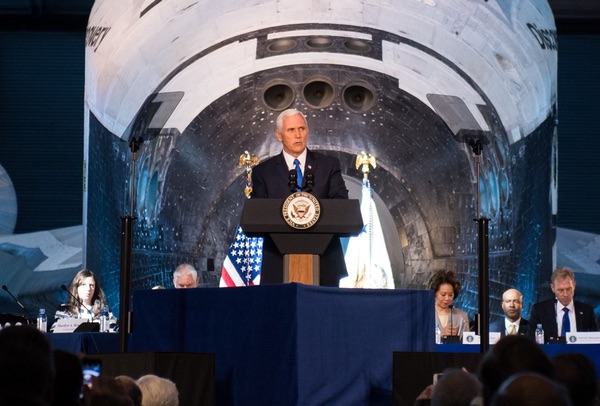A comparison of American and Japanese space policy structuresby Takashi Uchino
|
| Historically, the Space Council has had different functions, positions, and roles in each administration, and there is no established theory of the Space Council within the US government. |
Japan, the author’s country, changed its governmental structure in promoting space policy in 2012. But due to the shortage of materials translated into English, it seems not to be broadly known internationally about the Japanese government’s space activities including governmental structure and behavior.
Therefore, it is beneficial both to Americans and Japanese to compare the governmental structure for space policy in each country. This comparison can contribute for each countries’ space community to understand each country more deeply.
The National Space Council and comparisons to Japan
John Logsdon published a history of the Space Council prior to its current incarnation in the Trump Administration (see “Is creating a National Space Council the best choice?”, The Space Review, January 3, 2017.)
Historically, the Space Council has had different functions, positions, and roles in each administration, and there is no established theory of the Space Council within the US government. To consider its organizational influence on space policy, it is thought that it depended on factors such as its relationship with the president and the presence of competent staff.
Japan changed its governmental structure of space policy in 2012. From 2000 to 2012, the main role in planning space policy was allocated to the Ministry of Education, Culture, Sports, Science and Technology (MEXT), but this function was transferred to Cabinet Office (CAO) in 2012. Japan also came to have functions to coordinative organization to the relevant ministries related to space activities.1
At the current situation, the American and Japanese governmental structures of space policy can be described in the figure below. With the revival of the Space Council in the United States, it seems that the two countries have basically the same framework.
 Fig 1. Governmental chart in Space Policy of Japan and United States (larger version) |
However, there are several main differences between US and Japan:
(1) Committee on National Space Policy
In Japan, the Strategic Headquarters for National Space Policy (hereinafter “the Headquarters”) exists in the Cabinet. The Headquarters should be considered as a counterpart of the Space Council in US. The Headquarters is chaired by the Prime Minister and consists of all the other ministers. Despite the establishment of the Headquarters, Japan has the Committee on National Space Policy in the CAO (hereinafter “the Committee”.) The Committee consists of experts outside the government and discusses and develops drafts of Japan’s National Space Policy, to be decided at the Headquarters. The Committee plays the practical role of developing Japan’s national space policy, and the Headquarters acts as the only deciding function as the Cabinet.
(2) The resources of the Secretariat
Both Japan and the US have secretariats for the conference body, but the expertise of their staffs are different. The executive secretary of the US Space Council is Dr. Scott Pace, an expert on space policy and former director of Space Policy Institute of the George Washington University. In comparison, the director of the secretariat of the Headquarters and the Committee are responsible to an official who originally came from Ministry of Economy, Trade, Industry (METI) and is not always an academic expert on space policy.
| The President has signed three Policy Directives, including lunar exploration, regulatory reform, and space traffic management, within one year of its reorganization. By comparison, Japan does not publish new space policies as frequently. Why can the US publish its new policies, which include challenges, so quickly? |
The size of the staffs in the secretariat is also different. The author could not find public evidence of the size of the staff in the secretariat of the Space Council in US, although it is said that it numbers about seven or eight people. In comparison, the secretariat of Japan has 39 staff members, not counting the assistants and Quasi-Zenith Satellite System team members. In addition, the staffs are almost dispatched from relevant ministries as well as the director of the secretariat.
(3) Difference in roles imposed on NASA and JAXA
Although NASA is a governmental department in US, the Japanese space agency, Japan Aerospace Exploration Agency (JAXA), is not a governmental ministry. JAXA is known as an Incorporated Administrative Agency, and the Agency takes a role mainly to implement the policy that was developed by the government, usually by the competent minister. But in the practical case, JAXA takes a role as the counterpart to NASA in the context of carrying out space projects. Despite NASA focused on mission such as research and development, JAXA is required to support all relevant ministries with its technology, even if the project does not seem to be part of JAXA’s mission.2 Because of this, JAXA has a broader role than NASA, from national security to civil space.
(4) Other aspects
There are some other differences between the Space Council and its Japanese counterparts, such as the chairman and subcommittees. For example, while the President does not chair the Space Council, a role left to the Vice President, the Headquarters is chaired by the Prime Minister in Japan. Also, the lineups of the subcommittees under the Space Council and its counterparts are different, as shown in the figure below.
 Fig.2 Organizational chart of Space Subcommittees in Japan and US (larger version) |
Discussion
In the Trump Administration, the Space Council is welcomed by the US space community for its effort, which evaluates it as “energetic” or “not bureaucratic.” In fact, the President has signed three Policy Directives, including lunar exploration, regulatory reform, and space traffic management, within one year of its reorganization. By comparison, Japan does not publish new space policies as frequently. Why can the US publish its new policies, which include challenges, so quickly?
(1) The difference of definition of “Policy” and “Implementation”
One possible reason is the definitions of the words “policy” and “implementation” seem to be regarded differently in US and Japan.
| These factors seem to be the reason why Japan needs more time to publish new policies. In other words, Japan makes sure the policy will be executed on its original, and trustworthy, basis. |
In US, the word “policy” does not include its implementation. Policies are usually developed at the White House level and the federal departments have to implement the policies. The policies can be easily changed by the President’s mind, because the responsibility of deciding policies is under the President. Furthermore, the activities by the federal departments can be different from the initial policy due to many factors in the execution stage. Despite the frequent policy changes by the President, the process of developing US policy is clear to the space community, including the space industry. This enables the US space community to anticipate what will happen in the near future. This seems to contribute to the active change of US space communities.
In contrast, in Japan, the word “policy” is regarded as including its implementation. This is due to that the roles of policy development and its implementation that are allocated to each ministry in Japan. Despite the inter-ministerial organization, such as the Headquarters and its secretariat, policies in each area are normally developed by the ministry that has duties and responsibility there. In the policy development process, the ministry that has responsibility for the policy usually must coordinate with all relevant ministries before publishing the new policy. Also, when the Cabinet Decision is required, all ministries must agree before the decision is made. This coordination process takes much time. Furthermore, in the coordination process, the Ministry of Finance will oppose the policy if adequate resources for the policy can not be prepared.
These factors seem to be the reason why Japan needs more time to publish new policies. In other words, Japan makes sure the policy will be executed on its original, and trustworthy, basis. In addition, while the Prime Minister is the chairman of the Headquarters, it is difficult to determine the Prime Minister’s individual mind on the policy. Because the policy was coordinated within the ministries and completed evaluation of the Committee, taking the much time, the Headquarters appears only at the end of the policy developing process.
(2) The function of Secretariat
In addition, the functions of secretariat are also seemed to be different. In the US, the secretariat of the Council is headed by Scott Pace, who is an expert in space policy. New policies, such as space traffic management, are drafted by the executive secretary of the Space Council. This enables the US to develop new policies more strategically and quickly.
In Japan, the directors of the secretariat of the Headquarters and Committee are usually dispatched from METI and are not always an academic expert on space policy. Therefore, the investigation from the expert perspective by the Committee is needed before the decision of the Headquarters and announcement of new policies. Also, the preparation for the Committee’s evaluation needs more manpower because the Committee has many subcommittees among variety of areas, as shown in Figure 2, and the meetings of the Committee itself and subcommittees are held so frequently.
(3) Other concerns
Due to the change in 2012, the mission and requirements for JAXA were broadened from research and development to national security and promotion of the space industry. Despite the expansion, JAXA’s annual budget does not increase, because ministries that gained JAXA’s jurisdiction do not provide additional subsidies. Until now, only MEXT provides the budget for JAXA. This unbalanced budget and tasks requires JAXA to prioritize its activities and causes the delay of launching new projects. This is also another concern for slowing down of implementing policy in Japan.
Conclusion
Generally, the US system for developing space policy is more visible than Japan. This is beneficial for the space communities, including space industries, to anticipate what will happen in the near future. If the plan can’t be implemented as initially planned, changes and actions tend to occur in space-related sectors. This seems to contribute to the active movement of US space communities.
On the other hand, Japan does not publish a new policy until the resources that are needed to execute the plan are prepared. It takes more time than the US government, but the Japanese government makes sure that the policy will be executed. This mechanism contributes to increased reliability of the Japanese government, and it is beneficial international cooperative projects like International Space Station and other space exploration efforts. Also, Japan started an effort to compile the roadmap of the Basic Plan on Space Policy3 in order to increase the visibility of governmental space activities for the space community, both domestically and internationally.
Despite governmental organization frameworks that appear almost same, the internal scheme of the development and implementation of space policy are different in the two countries. It is important for those studying national strategy to analyze each country’s policy with this point of view.
Endnotes
- For more detail of 2012 change, see the article “Administrative reform of Japanese Space Policy Structures in 2012” by Keiichi Anan
- This originates the recommendation of the Special Committee on the Headquarter issued in January 13, 2012. And after this, it is included in the policies such as the Basic Plan on Space Policy (Cabinet Decision in January 2013) and JAXA’s Long-Mid term goals.
- See the Implementation Plan of the Basic Plan on Space Policy.
Note: we are temporarily moderating all comments subcommitted to deal with a surge in spam.
